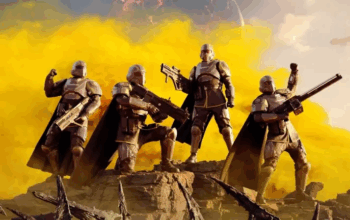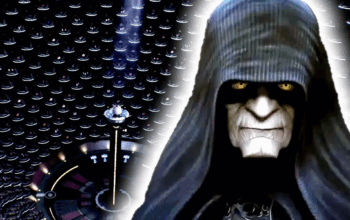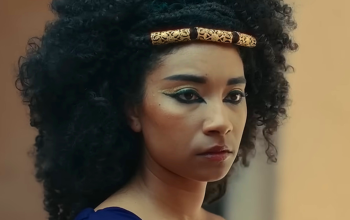Over the past 20 years, many paleo media outlets have presented the audience with a glimpse of prehistoric times. Most people think of documentaries such as the Walking with Dinosaurs and Walking with Beasts saga. However, not all such projects focus on dinosaurs and megafauna. Indeed the second most popular focus is on the evolution of man.

Considering that our distant ancestors encountered beasts, it is miraculous how humans arose to be the dominant species on the planet. However, there is no doubt that our ascension came at the cost of other species. One paleo-documentary that really hits this home is the miniseries Monsters We Met (aka Land of Lost Monsters in America).
Released by the BBC In 2003 and Narrated by Ian Holm, this 3-part miniseries focuses on human migration into new lands during prehistoric times.
In principle, it is an analysis of the gradual impact of how these first settlers began to shape their new world. As the title suggests, it depicts prehistoric monsters that these first settlers would have encountered. This article discusses the crucial aspects of each episode and the themes It carried that separated it from other such paleo docs at the time.
Episode 1: “The Burning”

The first episode follows an aboriginal family as they settled in Australia around 60,000 years ago. According to the show, these first Aboriginals helmed from today’s East Timor. Through their eyes, at first, things are looking up to the new arrivals as much of the vegetation and plant life resembles their home islands. However, as they venture deeper into this unknown land, they find dangers they have never seen before. Facing large bush fires, animals unknown, and even other hostile tribes already settled.
In this setting, Australia was more covered in scrub forests that were home to an abundance of species unknown in the rest of the world, including the Diprotodon, a wombat the size of a hippo, and Genyornis, a giant flightless duck relative. However, the monster of note is the giant lizard Megalania, who eats a prominent hunter after being kept in the shadows most of the episode.
Eventually, after noticing the weakness of the creature is that reptiles are sluggish in the cool early mornings, the tribe creates a massive bush fire that consumes the lizard in the flames. This event foreshadowed ice age Australia’s future as prehistoric aboriginals would overuse wildfires to both drives away threats and make more grazing lands for more manageable prey like Kangaroos.
This would be the first time in history that modern humans would use fire not just for cooking but also to reshape the landscape. This newfound power, however, would come at the cost of Australia’s mega beasts like Diprotodon. It was in Australia where the first mass extinctions occurred during the Pleistocene Epoch when humans were present.
Episode 2: “The Eternal Frontier”
This episode focused on humanity’s first incursions into America 13,000 years ago. The story revolves around the burial of a child discovered in 1968. The child was buried with hundreds of artifacts, including spearpoints made with obsidian and other semi-precious stones. Such spear points were designed to wound and kill the massive Ice Age fauna of their time. So the episode asks the question: “why was this child buried with these precious spearpoints?”.
Their elements in this episode were dated as there’s evidence that humans arrived even earlier, perhaps 20,000 years ago, than the show timeline. Nevertheless, themes carried in this episode are no less relevant today.
Like the last episode, it follows a small clan of proto-Siberians as they leave the Bering Strait land bridge to find themselves in what is now Montana. As they venture deeper into America, they encounter a variety of creatures, many familiar being the same game they find in Siberia, but there they encounter a number of ferocious predators in tow.
The main monster here was at first hinted at as the sabertooth. However, the truth is the sabertooth was minor compared to the other predators that ruled the American continent as the real culprit was the giant short-faced bear. Despite being fully CGI, its presence was terrifying. It looked more like a massive bulldog than a bear, and the animators, for the limited screen time it was given, wasted no time making its presence frightening.
Still, this was less about the monsters but about the environment and the human’s reaction to it. Like many fish out of water stories, the humans serve as an audience surrogate As they react the same way we would in this strange new land.
Eventually, the episode skips forward about 1000 years to about 12000BC. By this point, the mammoths and other Ice age beasts are disappearing. to which a family’s decedent, the main woman the show follows, has lost her only daughter. The child was buried with the very spear points that were made to hunt these creatures that had disappeared. The episode goes on to emphasize that the descendants of the Clovis would change their hunting strategies meant to preserve the remaining megafauna in the Americas. For a time, this method of hunting seemed to have worked for the next 10,000 years. However, a new wave of humans changed all that.
The final scene is set in 1876 during a bison hunt by pioneers in a truly upsetting scene. The descendants of the Clovis the Indians lost their livelihood when the last megafauna of the Ice Age, the Bison, was nearly lost. Even though the Bison have since regained numbers, it took their near total extinction for American colonists to save the species again. This pushes the recurring theme throughout human history as we have become the only species that perpetuated the extinction of countless species.
Episode 3: “End of Eden”

This episode mainly focuses on the Polynesians as they land in New Zealand in the year 1280AD. At that time, New Zealand would be the last landmass to be colonized by humans. The Island was populated exclusively by birds of every size. Most notable is the giant flightless Moa that could stand up to 9 ft tall.
There were also other birds their island descendants, the Māori, speak of in legends – such as the Haast Eagle, the only bird of its kind that can take down humans as this bird has hunted the giant Moas for millions of years.
What separates this episode from the other two is addressing why the Polynesians were forced to hunt these creatures than on other Pacific Islands. The first Polynesians likely intended to settle on the island to grow crops, but New Zealand’s temperate climate does not permit the kind of tropical agriculture there used to be. With their farming resources limited, the Maori have reverted to their hunter-gathering method as they’ve taken to hunting the Moa and other Large birds that lived there. Compared to other birds, Moas only lay a few eggs and take several years to reach maturity; this slow reproductive rate, combined with the Maori’s lack of understanding of bird populations combined, drove the animal to extinction.
Just like the previous episode, it time jumps to the 1400s, with Moa numbers dwindling to such low numbers the Mori resorted to firing to drive the remaining birds to extinction. As main food sources dwindled, so did the escalation of warfare between rival clans as they fought for dwindling resources. This depicts the natural consequences when natural resources are depleted one way, or other competing tribs are gonna defend what little resources they have left.
Just 300 years later, another mass extinction occurred in New Zealand when the Europeans arrived in 1769.
Much of the remaining forests were cleared away from sheep and other livestock. This destruction of the habitat, combined with the introduction of more domesticated species, drove more unique birds to extinction. The show complements how it is in human nature itself to conquer nature itself, a phenomenon that was not restricted to cities but to everywhere humans touch changes.
Conclusion

The remainder of the final episode somewhat montages the human impact on the earth and asks the critical question: “In pursuit of the monster, have we become monsters ourselves?”.
The very last two scenes in this miniseries give a very cryptic foreshadowing of the human race. It starts with a Maori shaman and his disciples planting a Totem pole meant to guard a section of forest as “sacred” to be protected from hunters, with the narration saying that plants and animals began to recover from these acts of preservation. This scene was important in addressing how like many native peoples, learned to preserve and manage their ecosystem after the beast they depended on was gone. Scenes like these are meant to instill hope that humans can redress the balance caused in the past.
But this optimism is subverted when the final scene ends on Easter Island, detailing how the Polynesians settled and destroyed the forests for agriculture and when all the usable vegetation was gone, the stranded people succumbed to warfare and cannibalism. Coming out of a civilization that created statues and the only Polynesian language that was written. This was a haunting scene to end as is a reminder that this can happen to any civilization.
“Here is the paradox of humans we are capable of such triumphant creation, and yet we are also highly capable of perpetrating such horror upon the natural world.”
– Ian Holm
The core theme of this series is that humans can address past grievances, but sometimes it takes the loss of the most famous animals to live to start that. Considering that this documentary was made almost 20 years ago, it was relevant then, and it’s relevant now.
What is important now compared to extinctions back then or even just 100 years ago is despite the real concerns for climate change and over-exploitation still ongoing, there are far more people aware and attempting to save what the planet has left. Then there were centuries ago; it’s just a question of what time we have. The message of the film is merely an observation of the complex life of humans. The ending with easter Island is meant to be a warning for all human civilization.





Top ,.. top top … post! Keep the good work on !